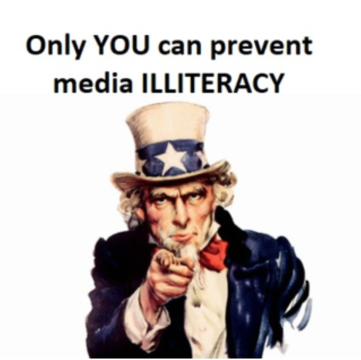He has partnered with organizations like NCTE, ASCD and ISTE, published multiple works and been nationally recognized and awarded for his work in the field. In addition, Frank has also contributed to the analysis and creation of media literacy standards for education.
He spoke with the Learning.com team about the urgency of integrating media literacy in education and tangible strategies to practice media literacy in your own life.
What Is Media Literacy?
“Media literacy is an ecosystem that encompasses how we access resources, analyze content, synthesize information, communicate findings and perspectives and even create artifacts.”
What is ‘literacy’ in the 21st century? “Reading, writing, listening, speaking and VIEWING,” answers Frank.
He also shares how literacy, and specifically media literacy, is an ecosystem that encompasses how we access resources, analyze content, synthesize information, communicate findings and perspectives and even create artifacts.
A quote Frank shared by Ernest L. Boyer, former president of the Carnegie Foundation for the Advancement of Teaching and United States commissioner of education, reads:
“It is no longer enough simply to read and write. Students must also become literate in the understanding of visual images. Our children must learn how to spot a stereotype, isolate a social cliché́, and distinguish facts from propaganda, analysis from banter and important news from coverage.”
The Impact of Technology
At the helm of this definition of media literacy is technology, which is entirely upending how we interact with the media. The impact of technology advances on media creation and consumption, however, is certainly not new; inventions like the printing press, radio, television, the internet and now connected devices have similarly made media more accessible to consumers and have gradually made it easier for people to create media as well.
Throughout this time, media literacy has grown and evolved, so it makes sense that this continues to be a focus. However, it is also essential to understand that recent advancements and events–the polarization of news sources, the advent of fake news and the broad mechanisms to disseminate these slanted and false media–have made media literacy even more relevant and necessary.
And as media literacy evolves, the topic becomes increasingly nuanced and complex. Frank emphasized this, sharing that “most people think of literacy as words on a page. That has to change. Media ARE texts designed to be read, analyzed, constructed and reconstructed.”
In clarifying the evolution of media literacy, he noted, “The truth is media literacy is this huge umbrella that encompasses many topics (propaganda, bias, stereotypes, representation, agenda-setting and more). Unfortunately, the phrase media literacy today is being used to mean everything from information literacy to digital literacy. It is much different and I am finding that real media literacy has gotten lost in these conversations.”
Literacy At Large
Indeed, there are so many new forms of ‘literacy’ as the types of media content, mechanisms for generating them, their almost universal accessibility and viral nature of content have overhauled traditional media. To conceptualize the interplay between these forms of literacy, Frank shared this report by the RAND Corporation, which specifically lays out the different types of literacies in existence today.
According to the report, “At its core, media literacy refers to the abilities to access, analyze, evaluate and communicate various media messages,” which has grown to “focus more on competencies related to participation and creation.”
Other literacies include:
- Information literacy: recognizing “when information is needed” and locating, evaluating and using “effectively the needed information.”
- News literacy: “consuming, interpreting and publishing news based on knowledge of accepted journalistic standards”
- Critical media literacy: identifying “implicit and explicit biases and oppression in media messages”
- Digital literacy: focusing on “online spaces,”
- Visual literacy: analyzing “graphics and images”
- Science literacy: studying “analytical concepts”
The types of literacies don’t end there though. It can feel overwhelming, but there are connective threads that weave throughout these, which are often those competencies specific to media literacy – to critically analyze content, to be informed and to question. Media literacy fosters the highly sought-after 21st-century skills, serves as a prerequisite to digital citizenship and acts as a foundation for literacy as a whole.
The Data
Technology changes our relationship with media and the nature of how we consume it. For example, when using social media networks or news apps, feeds are tailored based on a person’s pauses or clicks, which leads to the singularization of content to a person’s pre-held worldview.
And when considered in the context of other media trends–for example, the fact that most adults don’t read more than a headline before reposting an article and over 75 percent of adults couldn’t identify fake news–the outlook becomes much more stark. In essence, people are reading curated lists of headlines, personalized to their preferences and are unable to discern what is real or what is fake and likely won’t take the time to click into the article to do the work.
What’s more, a study by Stanford found that “82 percent of middle-schoolers couldn’t distinguish between an ad labeled sponsored content and a real news story on a website.”
Additionally, over two-thirds of students shared that they wouldn’t mistrust a post by a bank executive arguing for better financial planning.
And, “nearly four in 10 high-school students believed, based on the headline, that a photo of deformed daisies on a photo-sharing site provided strong evidence of toxic conditions near the Fukushima Daiichi nuclear plant in Japan, even though no source or location was given for the photo.”
Changing the Mindset of Consumers
Frank pointed out that “Social media is feeding into the obsession of satisfying people’s need to have something quick. Unfortunately, that leads to superficiality. A headline or a tweet is only a summary–readers need to understand that there is always more to the story.”
As Frank put it, “there are many excellent sources of information, IF you know where to find it. And if readers will take the time to explore reliable and trustworthy sources.” To this end, he shared this media bias infographic, which is especially helpful and can serve as a quick reference point for news consumers to understand how their preferred news sources carry their own biases and perspectives.
“Media literacy emphasizes reflection,” Frank continued. “Current advice also includes stopping and verifying what one reads, hears and sees. Researchers are also advising…lateral reading in order to verify what’s online.”
Media Literacy Strategies
To help demonstrate what this means, Frank shared this video series that offers three strategies, derived from the process followed by professional fact-checkers, to identify what is factual and fictitious.
- Investigate the source. Determine whether the publisher of this content is legitimate simply by searching the name of the organization followed by ‘Wikipedia’. The page that populates in the search results will tell whether it’s a trustworthy source.
- Find the original source. When an article shares a study, report, or piece of data as evidence, go to the original source and repeat the process above.
- Look for trusted work. Websites like Factcheck.org and Snopes will tell whether a story is purportedly true or not; or simply google the story and see how and if others are reporting on it.
Ultimately, illegitimate, inaccurate and biased news still exists, but media literacy helps consumers to navigate through the “noise,” find what is true and construct their own opinions and judgments on the matter.
A Media Literacy Worldview
The trend of media illiteracy is concerning because the media has such a significant impact on how we process events around us and is instrumental in keeping us informed on critical subjects, including how to vote. Moreover, in a democratic society, it’s essential people have access to quality information and are equipped with the tools to seek this out.
And this is where Frank’s passion lies – filling the knowledge and skills gaps that exist today by focusing on education. In a later article, we will dive into how media literacy is taking shape in the education space and what educators can do to advance this work.
The fact is that media literacy is a worldview – it cultivates a different perspective to everything we read, see and hear. It’s counterculture in a lot of ways to the quick snippets of information that inundate us every day. Media literacy attempts to cut through this, to reframe how people understand and conceptualize information, data and media. This worldview is essential to democratic and digital citizenship and, ultimately, enhances how we live; media literacy is liberating – it enables us to form our own judgements, educate ourselves and model for others.
Embedding media literacy in education requires thoughtful effort, so Frank offered this image as inspiration:

A version of this blog was originally published in 2019 by Learning.com.
About Frank Baker
In 1987, Frank joined the Orange County (Orlando, FL) Public School System as an administrator in the areas of Instructional TV/Distance Education. While there, he collaborated with both Time Warner Cable and The Orlando Sentinel (NIE) to bring media literacy education to teachers and students. Upon returning to South Carolina in 1997, Frank taught a college-level media literacy course for educators and developed a nationally recognized media literacy resource website. He assisted the SC State Department of Education’s English Language Arts team in revising the state teaching standards to include elements of media literacy. Frank is the author of “Coming Distractions: Questioning Movies,” “Political Campaigns & Political Advertising: A Media Literacy Guide,” “Media Literacy in K-12 Classrooms and “Close Reading The Media” (all of which can be found here: https://frankwbaker.com/publications/). He maintains the education resource website The Media Literacy Clearinghouse (www.frankwbaker.com). Frank is a 2019 recipient of the Global Media and Information Literacy (MIL) Awards by the UNESCO-led Global Alliance for Partnership on Media and Information Literacy (GAPMIL).

Learning.com Team
Staff Writers
Founded in 1999, Learning.com provides educators with solutions to prepare their students with critical digital skills. Our web-based curriculum for grades K-12 engages students as they learn keyboarding, online safety, applied productivity tools, computational thinking, coding and more.
Further Reading
5 Useful AI Tools for Teachers in 2024
Looking for the best AI for teachers? Check out these 5 top AI tools in 2024 that can transform your teaching experience and save you time
Improve Student Performance on Online Assessments with Digital Literacy
Online assessments have become increasingly prevalent in education, especially with the rise of digital learning environments and the need for...
Overlooked Digital Skills Students Need to Thrive in a Digital World
As the digital landscape continues to evolve at a rapid pace, educators, parents and policymakers are increasingly focused on preparing students for...




